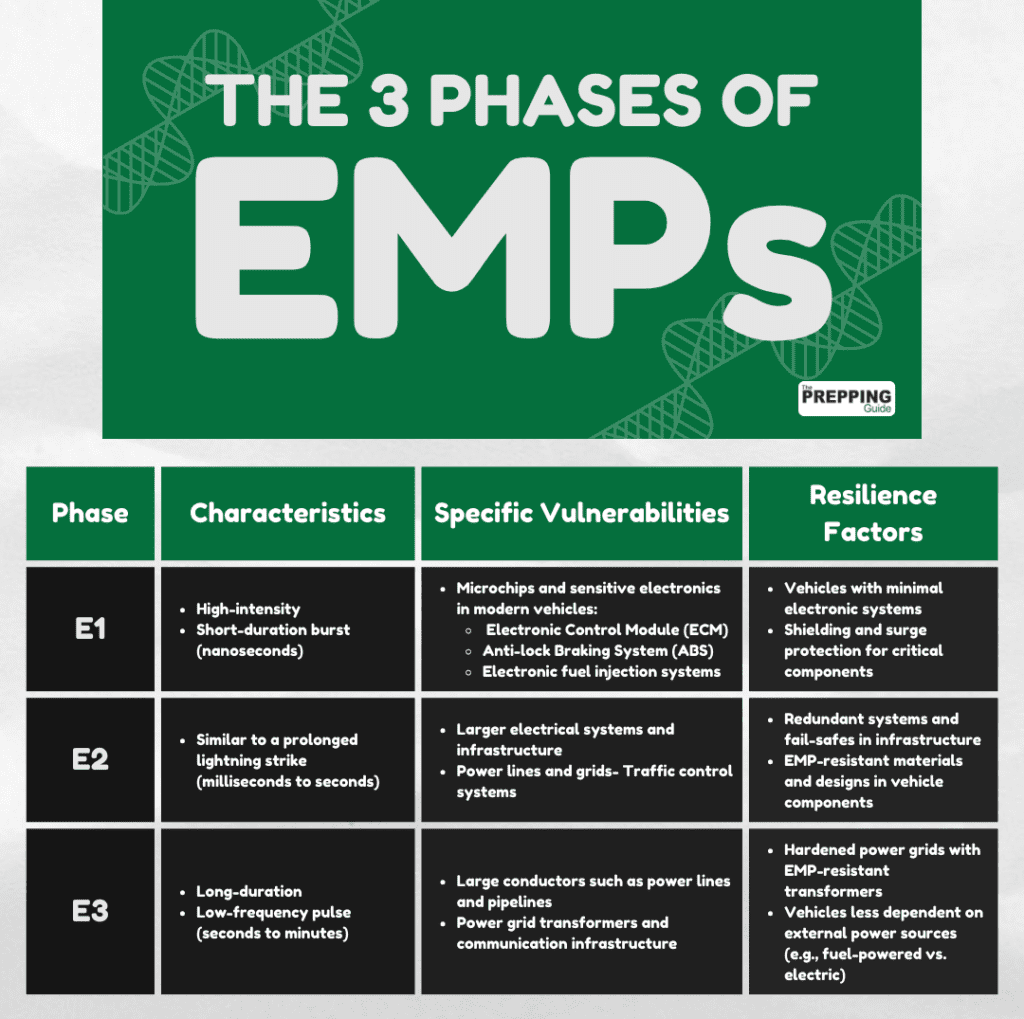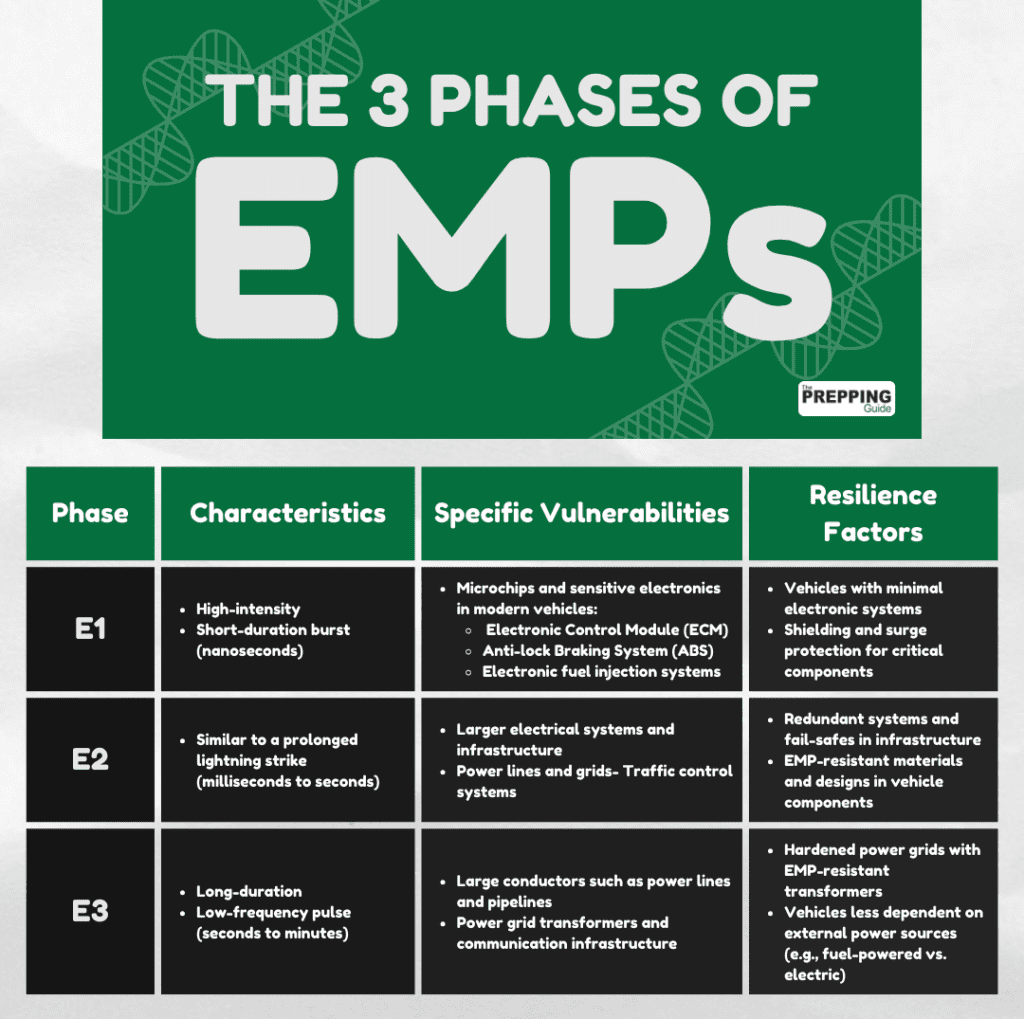If you’re serious about emergency preparedness, one topic that should be on your radar is EMP-proof vehicles. An EMP, or electromagnetic pulse, can disrupt or even destroy electronic devices, leaving modern cars inoperable. Imagine cruising down the road when suddenly every electronic device in your car goes kaput—no more radio, no more navigation, and worst of all, no more engine.
Key Takeaways
- Understanding the various phases of an EMP, like E1, E2, and E3, is important. Each phase has its own challenges and vulnerabilities, impacting electronic devices and infrastructure in distinct ways.
- EMPs can have catastrophic effects on modern vehicles, which are heavily reliant on electronic systems.
- EMP-proof vehicles incorporate essential features like Faraday cage protection, redundant systems, manual controls, shielded wiring, and simplified electronics.
- Modifying a vehicle for EMP resilience involves steps like installing Faraday cages, surge protectors, shielded wiring, and manual overrides.
This article explains what makes a vehicle EMP-proof, how to modify your ride for resilience, and the options available. By preparing your transportation to withstand EMPs, you ensure a key aspect of your readiness strategy remains intact, enabling you to maintain autonomy in the face of unpredictable threats.
Understanding EMP and Its Phases
An EMP stands for Electromagnetic Pulse. It’s a burst of electromagnetic radiation that can disrupt, damage, or destroy electronic devices and systems.

EMPs can be caused by natural events such as solar flares or by human-made devices like nuclear weapons detonated in the atmosphere.
The pulse can induce current and voltage surges in electronic circuits, damaging or destroying sensitive components such as microchips and transistors.
This disruption can have widespread effects on telecommunications, power grids, transportation systems, and other critical infrastructure.
The 3 Phases of EMPs
EMP events are often discussed in terms of three phases:
E1 Phase
The E1 phase is the initial, extremely fast pulse of electromagnetic energy that occurs within nanoseconds after a nuclear detonation or other high-energy event.
This phase is characterized by its high intensity and ability to damage or destroy electronic components by inducing high voltages and currents. It primarily affects semiconductor devices like integrated circuits and transistors.
E2 Phase
The E2 phase follows the E1 phase and typically lasts for microseconds to milliseconds. It consists of a slower pulse of electromagnetic energy, similar to a strong burst of lightning.
While the E2 phase is less intense than the E1 phase, it can still cause damage to electronic equipment, particularly power lines, and long conductors.
E3 Phase
The E3 phase lasts from seconds to hours and results from the Earth’s magnetic field interacting with ionized particles from a nuclear explosion. It causes a geomagnetic storm effect, disrupting power grids and transmission lines.
Unlike the E1 and E2 phases, which directly affect electronic devices, the E3 phase focuses more on the power infrastructure itself.
To give you a better and clearer idea, here’s a table comparing the different phases of EMPs.

Comprehensive List of EMP Proof Vehicles
While a true “EMP-proof” vehicle might be a myth, understanding which ones are more resilient can be a game-changer in your preparedness plan. Here’s a breakdown of the different categories of vehicles known for their EMP resilience.
Military Vehicles with EMP Protection

Military vehicles are often designed with EMP protection in mind, incorporating features like Faraday cages, metal shielding, and EMP hardening initiatives.
These measures aim to ensure that the vehicles maintain operational integrity during an EMP attack.
Studies show that modern military vehicles with high electronic and electrical integration face significant threats from EMPs. Design strategies should enhance electromagnetic protection by configuring around electrical discontinuities like windows and gaps.
Notably, military vehicles like Humvees have undergone rigorous testing and include upgraded chassis and protection systems to withstand EMPs to a certain extent. However, they are not completely impervious to such threats.
Military vehicles are often designed with EMP protection due to the nature of modern warfare. Here are some key features of these robust machines:
- HMMWV (Humvee): Designed with EMP resilience in mind, potentially including features that enhance their ability to function after an EMP event.
- MRAP (Mine-Resistant Ambush Protected): Due to their role in modern warfare, MRAP design might incorporate features that offer some degree of electromagnetic shielding. This could include strategic use of metal in the chassis or compartments housing critical systems.
- JLTV (Joint Light Tactical Vehicle): The design of JLTVs may incorporate features that enhance their ability to function after an EMP event, potentially including some level of electromagnetic shielding and surge protection for critical systems.
- Stryker Armored Vehicle:The design of Stryker vehicles likely prioritizes EMP resilience, potentially including hardened communication and control systems to improve their chances of functioning after an EMP event.
- M1 Abrams Tank: The M1 Abrams tank design likely prioritizes EMP resilience to protect critical electronic warfare systems and core operational controls, potentially including features that enhance their ability to function after an EMP event.
Civilian Vehicles Modified for EMP Resilience

For civilian vehicles, EMP resilience often lies in their simplicity and the absence of sensitive electronics.
Older vehicles, especially those manufactured before the mid-1980s without electronic control units (ECUs), are generally considered less vulnerable to EMP effects. This is because they rely on mechanical systems rather than sensitive microelectronics for critical functions like ignition and fuel injection.
Some enthusiasts further modify these older vehicles by installing EMP protection technologies like ferrite T.R.A.P.S. to absorb EMP energy and protect the electrical systems.
Adapting civilian vehicles for military applications, particularly regarding their electromagnetic compatibility (EMC) properties, can be challenging. Research shows that the electromagnetic environment for these vehicles can significantly affect their operational readiness, requiring careful consideration during design to ensure compatibility.
Some civilian vehicles can be modified to enhance their EMP resilience. Here are notable examples and their key modifications:
- Ford F-150: Aftermarket EMP hardening kits might offer some protection for the engine and essential electronics, but the effectiveness can vary.
- Jeep Wrangler: Due to its simpler electrical systems, Jeeps might benefit more from EMP hardening compared to other modern vehicles. Aftermarket modifications could potentially improve EMP resilience.
- Toyota Land Cruiser: While upgrading some components for better EMP resistance might be possible, extensive modifications to create redundant systems and hardened microprocessors are unrealistic for aftermarket applications.
- Chevrolet Suburban: Surge protectors might be installed for specific components to provide limited EMP protection. Adding conductive coatings to the entire vehicle is impractical.
- Dodge Ram: Converting to a mechanical ignition system might be possible for older Dodge Rams, but not necessarily easy for newer models. Shielding critical components with aftermarket enclosures offers some potential for improvement, but not a complete solution.
Concept Vehicles with EMP Shielding
Concept vehicles with EMP-proof features often explore innovative designs and technologies to enhance resilience against EMPs.
These might include advanced materials, shielding techniques, and electronic designs that are less susceptible to electromagnetic interference.
While concept vehicles provide a glimpse into potential future developments, their practical availability and effectiveness can vary widely and remain largely experimental.
EMP Effects on Transportation

Understanding how an EMP affects transportation is crucial for serious preparedness. Modern vehicles, reliant on electronic systems, are especially vulnerable.
Modern cars are packed with electronic parts, from ignition systems to advanced driver assistance systems (ADAS). These parts are all at risk from the powerful bursts of an EMP.
For example, the E1 phase can instantly destroy the microprocessors controlling everything from engine management to navigation. Even starting your car depends on electronic signals that an EMP could disrupt.
Moreover, many vehicles now connect wirelessly for GPS, remote diagnostics, and entertainment. These connections add more vulnerabilities.
An EMP could not only disrupt these systems but also cause surges that harm other connected parts. While this connectivity is convenient, it makes modern vehicles more likely to fail widely during an EMP.
Historical Examples of EMP Effects on Transportation
While full-scale EMP events are rare, there have been instances that highlight their potential impact.
One notable example is the Starfish Prime test in 1962, where a high-altitude nuclear explosion caused electrical damage hundreds of miles away in Hawaii. This event demonstrated the far-reaching effects of an EMP on electronic systems, even those not directly in the blast zone.

Another example is the Carrington Event of 1859, a powerful geomagnetic storm caused by a solar flare. While this predated modern electronics, telegraph systems at the time experienced significant disruptions and damage.
If a similar event were to occur today, the impact on our electronically dependent transportation systems could be catastrophic. These historical precedents underscore the need for robust EMP preparedness.
Key Features of EMP Proof Vehicles
When it comes to safeguarding your transportation from an EMP, understanding the key features that make a vehicle resilient is crucial. Here are the elements that can help vehicles withstand electromagnetic pulses.
- Faraday Cage Protection: This involves encasing critical electronic components within a conductive enclosure that shields them from electromagnetic fields. It’s similar to how a microwave oven’s door prevents radiation from escaping.
- Redundant Systems: Vehicles with multiple, independent systems for critical functions can maintain operability even if some systems fail. For example, having both electronic and mechanical fuel pumps ensures the vehicle can run if one system is compromised.
- Manual Controls: Incorporating manual overrides for essential functions like ignition, brakes, and fuel supply can ensure the vehicle remains operational even if electronic systems are down.
- Simplified Electronics: Vehicles with fewer electronic components are naturally more resilient to EMPs. Older, pre-electronic ignition systems are a good example of this.
- Shielded Wiring: Using specially designed wiring that is resistant to EMPs can prevent the pulse from traveling through and damaging the vehicle’s electronic systems.
Now, how does an EMP-proof vehicle differ from a regular vehicle? Here’s a breakdown:

Technologies Used in EMP-Resistant Vehicles
Several advanced technologies are utilized to enhance a vehicle’s resistance to EMPs. Here are some of these technologies:
- EMP Hardened Microprocessors: These are specially designed to withstand the high-intensity pulses of an EMP without being damaged, ensuring that essential vehicle functions remain operational.
- Surge Protectors: High-quality surge protectors can prevent damage by blocking or shorting to ground any excess voltage caused by an EMP, protecting the vehicle’s electrical systems.
- Grounding Systems: Effective grounding systems can dissipate the electromagnetic energy from an EMP, preventing it from damaging electronic components within the vehicle.
- EMP Shielding Materials: These materials, such as specialized foils and coatings, are applied to the vehicle’s body and critical components to block and absorb EMP energy.
- Mechanical Ignition Systems: Reverting to or including mechanical ignition systems can ensure the vehicle can start and run without relying on vulnerable electronic components.
Steps to Modify Your Vehicle for EMP Protection
Not all cars can be easily converted, as modern vehicles rely heavily on electronic components for engine control and infotainment systems. Older vehicles with fewer electronic components are generally easier to protect.
Modifying a vehicle for EMP protection involves shielding its electrical and electronic systems from potentially damaging effects. The extent of modification needed depends on the vehicle’s complexity and specific protection requirements.
Some basic protective measures can be done as DIY projects, such as grounding the vehicle or using metal shielding materials. However, comprehensive EMP protection usually requires specialized knowledge and equipment.
If you plan to do the whole process yourself, below are the steps you can use as a guid:
- Assess Vulnerable Components: Identify which electronic systems in your vehicle are most susceptible to EMP damage, such as the engine control unit (ECU), ignition system, and communication devices.
- Install Faraday Cages: Enclose critical electronic components in Faraday cages. This involves placing these components inside conductive boxes or wrapping them in conductive materials to shield them from EMP.
- Add Surge Protectors: Install high-quality surge protectors to prevent voltage spikes caused by EMP from damaging your vehicle’s electronics. These devices will absorb excess voltage and protect your circuits.
- Shield Wiring: Replace existing wiring with shielded cables that can resist EMP interference. This helps to prevent the EMP from traveling through the wiring and damaging connected components.
- Install Redundant Systems: Incorporate redundant systems for essential functions like fuel delivery and ignition. This can include mechanical backups for electronic components, ensuring your vehicle can operate if electronics fail.
- Grounding: Improve your vehicle’s grounding system to dissipate EMP energy effectively. This involves connecting critical components to a common grounding point to safely divert excess energy away from sensitive electronics.
- Manual Overrides: Equip your vehicle with manual controls for essential functions, such as ignition and fuel pumps, so it can be operated without relying on electronic systems.

Cost Considerations for EMP Vehicle Modifications
Modifying a vehicle for EMP resilience can vary significantly in cost depending on the level of protection desired.
Basic modifications, such as installing surge protectors and shielding wiring, might cost between $500 to $1,000. This includes the cost of materials and some basic tools if you’re planning to do it yourself.
For more comprehensive modifications, including the installation of Faraday cages, redundant systems, and professional-grade shielding, costs can escalate to $3,000 to $5,000 or more.
These higher costs reflect the advanced materials, specialized tools, and potential professional labor required to ensure the highest level of protection.
Now, should you go and do it yourself or get professional help?
DIY EMP car protection is cheaper and lets you customize, but requires knowledge and tools. Professionals offer guaranteed, advanced EMP shielding (custom cages, grounding) for a higher price. Choose DIY for budget and control, professional for guaranteed top-notch protection.
Maintenance and Testing of EMP Proof Vehicles

Maintaining your EMP-proof vehicle involves regular checks and updates to ensure all protective measures are functioning correctly. It’s recommended to perform a comprehensive inspection every six months.
This includes checking the integrity of Faraday cages, testing surge protectors, and inspecting shielded wiring for wear and tear.
In addition to these checks, regular vehicle maintenance, such as oil changes, brake inspections, and tire rotations, should not be neglected. Keeping your vehicle in optimal condition ensures that both its mechanical and EMP-protection systems are reliable and ready to perform when needed.
How to Perform Routine Checks and Updates
Performing routine checks and updates on your EMP-proof vehicle involves several steps. Here’s a guide to help you through the process:
- Inspect Faraday Cages: Check the condition of the Faraday cages around your vehicle’s critical components. Look for any signs of damage or corrosion and repair or replace them as needed.
- Test Surge Protectors: Use a multimeter to test the functionality of your surge protectors. Ensure they are still capable of absorbing and diverting voltage spikes effectively.
- Examine Shielded Wiring: Inspect all shielded wiring for any signs of wear, damage, or corrosion. Replace any compromised wiring to maintain effective EMP protection.
- Check Grounding Systems: Verify that all grounding straps and connections are secure and free of corrosion. A solid grounding system is crucial for dissipating EMP energy.
- Review Redundant Systems: Test the functionality of any redundant systems, such as mechanical fuel pumps or manual ignition controls, to ensure they are operational and ready to take over if needed.
Facilities and Services for EMP Testing
Several facilities and services specialize in testing vehicles for EMP resilience. Here are some notable options:
- Military Testing Facilities: Some military bases offer EMP testing services for civilian vehicles. These facilities have the equipment to simulate EMP events and assess your vehicle’s resilience.
- Private EMP Testing Labs: There are private companies that specialize in EMP testing for various types of equipment, including vehicles. These labs can provide detailed reports on your vehicle’s EMP protection.
- Automotive Service Centers: Certain advanced automotive service centers offer EMP testing as part of their suite of services. These centers can test your vehicle’s electronics and suggest improvements for better EMP resilience.
- DIY Testing Kits: For those who prefer a hands-on approach, there are DIY EMP testing kits available. These kits allow you to perform basic EMP tests at home, though they may not be as comprehensive as professional services.
Conclusion

The rise of EMP-proof vehicles shows a proactive approach to boosting emergency preparedness in today’s world.
Electromagnetic pulses pose a big threat to regular vehicles since they rely on electronic systems for basic functions like ignition, navigation, and communication.
EMP-proof vehicles have strong shielding, like Faraday cages and surge protectors, along with backup systems to endure these threats and keep running in tough conditions.
Understanding EMP’s different phases—E1, E2, and E3—helps tailor vehicle protection against their varying intensities and effects.
Whether for military or civilian use, the technology and strategies in EMP-proof vehicles are crucial for maintaining independence and ensuring your transportation stays functional despite unexpected electromagnetic disruptions.
FAQ
What year vehicles are immune to EMP?
Vehicles manufactured before the early 1980s are generally considered immune to EMPs because they lack the sensitive electronics found in modern cars.
Older models with mechanical ignition systems and minimal electronic components are less likely to be affected by an EMP event.
What motorcycles can survive an EMP?
Motorcycles with carbureted engines and minimal electronic systems, typically those manufactured before the 1980s, are more likely to survive an EMP.
Examples include classic models like the Honda CB series and early Harley-Davidsons, which rely on mechanical systems rather than electronic controls.
Can tanks survive EMP?
Military tanks are often designed with EMP protection in mind. They are equipped with EMP-hardened electronics and redundant systems to ensure operational capability even after an EMP event.
For instance, modern tanks like the M1 Abrams include extensive shielding and surge protection to safeguard against EMPs.

Then the local gas stations are raided and drained. No fresh fuel coming. Towers are down, alternator and starter wires are fused, followed by a second hit in 72 hours, likely a third after that … welcome to the middle ages.